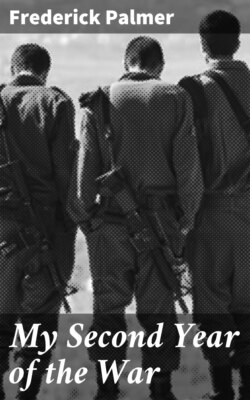My Second Year of the War

Реклама. ООО «ЛитРес», ИНН: 7719571260.
Оглавление
Frederick Palmer. My Second Year of the War
My Second Year of the War
Table of Contents
BACK TO THE FRONT
II. VERDUN AND ITS SEQUEL
IV. READY FOR THE BLOW
V. THE BLOW
VII. OUT OF THE HOPPER OF BATTLE
VIII. FORWARD THE GUNS!
X. ALONG THE ROAD TO VICTORY
XI. THE BRIGADE THAT WENT THROUGH
XII. THE STORMING OF CONTALMAISON
XIV. THE CAVALRY GOES IN
XV. ENTER THE ANZACS
XVI. THE AUSTRALIANS AND A WINDMILL
XVIII. A TRULY FRENCH AFFAIR
XIX. ON THE AERIAL FERRY
XXI. BY THE WAY
XXII. THE MASTERY OF THE AIR
XXIII. A PATENT CURTAIN OF FIRE
XXV. CANADA IS STUBBORN
XXVI. THE TANKS ARRIVE
XXVIII. CANADA IS QUICK
XXIX. THE HARVEST OF VILLAGES
XXXI. AU REVOIR, SOMME!
Отрывок из книги
Frederick Palmer
Published by Good Press, 2019
.....
The swift march of a division or a brigade from reserve to the flank at the critical moment has often turned the fortune of a day. All manoeuvering has this object in view. Superior numbers facilitate the operation, and victory has most often resolved itself into superior numbers pressing a flank and nothing more; though subsequently his admiring countrymen acclaimed the victor as the inventor of a strategic plan which was old before Alexander took the field, when the victor's genius consisted in the use of opportunities that enabled him to strike at the critical point with more men than his adversary. In flank of the Southern Confederacy Sherman swung through the South; in flank the Confederates aimed to bend back the Federal line at Kulp's Hill and Little Round Top. By the flank Grant pressed Lee back to Appomattox. Yalu, Liao Yang and Mukden were won in the Russo-Japanese war by flanking movements which forced Kuropatkin to retire, though never disastrously.
Pickett's charge at Gettysburg remains to the American the most futile and glorious illustration of a charge against a frontal position, with its endeavor to break the center. The center may waver, but it is the flanks that go; though, of course, in all consistent operations of big armies a necessary incident of any effort to press back the wings is sufficient pressure on the front, simultaneously delivered, to hold all the troops there in position and keep the enemy command in apprehension of the disaster that must follow if the center were to break badly at the same time that his flanks were being doubled back. The foregoing is only the repetition of principles which cannot be changed by the length of line and masses of troops and incredible volumes of artillery fire; which makes the European war the more confusing to the average reader as he receives his information in technical terms.
.....